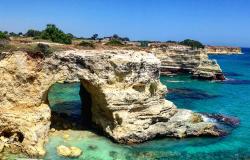Holy Roman Emperor Frederick II had German and Norman blood, but always felt that Italy, and especially Puglia, was his home. A lover of art and science, a skilled warrior, a tireless traveler, an enthusiastic hunter, Frederick II transformed the look of Puglia, dotting the region with spectacular castles, some of them still preserved today and worth seeing.
The itinerary on the footsteps of Emperor Frederick II begins at the Castle of Lucera in the province of Foggia. The castle was built in 1233 on the foundations of a Romanic cathedral. Frederick II had it built to house (and isolate) the Saracen rebels in Sicily, hoping to bring peace to the island. Located on top of Mount Albano, the complex included the imperial palace, the royal mint, the Treasury Room, and, according to legend, the emperor’s harem. Between 1269 and 1283, Charles I of Anjou, who succeeded Frederick as the King of Sicily, made the fortress the largest in the region, equipping it with 14-meter-high walls.

[Castle of Lucera.]
The second stop on this itinerary is the Castle of Barletta, first erected in the 10th century by the Normans. During the Crusade period, it was a used as barracks for soldiers leaving for and returning from the Holy Land. It was upgraded and enlarged under the reign of Frederick II, between 1225 and 1228. It was from this castle that the emperor launched the Sixth Crusade in 1229, and when he returned from the Holy Land, he resided in the castle for two months. The castle was later expanded under the House of Anjou, when Barletta became an important center of Aragonese-Spanish control in the area. The four massive bastions were added in the 15th century. The Castle of Barletta now houses the Civic Museum, which features a 13th-century bust supposedly portraying Frederick II.

[Castle of Barletta.]
Only a few kilometers from Barletta is the most famous castle built by Frederick II, the austere and majestic Castel del Monte (Italian for "Castle of the Mountain"), built in the 13th century. A UNESCO World Heritage Site, Castel del Monte boasts a unique geometric design. The emperor imbued it with symbolic significance, as reflected in the location, the mathematical and astronomical precision of the layout (studied so as to create symmetries of light during the winter solstice and summer equinox) and the perfectly regular shape (which uses eight as a guiding number). Built on a small promontory in the Murge plateau, near the monastery of Santa Maria del Monte, the fortress is an octagonal prism with an octagonal tower at each corner. Both floors have eight rooms and an eight-sided courtyard occupies the castle's center. The castle’s symbolism still intrigues scholars. Castel del Monte is considered a unique piece of genius medieval military architecture, blending elements of diverse styles and traditions from different times in history: classical antiquity, the Islamic Orient and north-European Cistercian Gothic. (Fun fact: Castel del Monte appears on the Italian version of the one-cent euro coin).

[Castel Del Monte.]
The itinerary continues south to Bari, where we find the Castello Svevo, on the outskirts of Bari Vecchia (old Bari). The fortress already existed in Roman times, as confirmed by Horace and Tacitus, but developed around 1132 with Norman king Roger II. It was destroyed in 1156 by king William I of Sicily and rebuilt and reinforced in 1233 by Fredrick II. During the Angevin domination, it went through several modifications. It was later donated to the Sforza family and, when returned to the King of Naples, transformed into a prison and barracks. The castle is surrounded by a moat and can be accessed from a bridge on the southern side. Currently used for exhibitions, it has preserved the Aragon walls and Swabian tower. According to legend, in 1221, Frederick II met Saint Francis of Assisi here. To test the friar’s moral principles, the emperor had a courtesan sent to Francis's room and spied through a peephole to see what happened. Francis sent the woman away, and Frederick was so impressed he spent the night conversing with Francis.

[Castello Svevo.]
The last stop on this itinerary is the little-known Castle of Sannicandro, located in the charming borgo by the same name in the province of Bari. Built in 916 as defense against Saracen attacks, the building was remodeled by Frederick when he added the large baronial palace in 1242. In a hidden area of the castle, the emperor built his beloved secret places for falconry, inaccessible and without any light, which he himself remembers in the hunting treatise he wrote for his son over the course of 30 years, "De arte venandi cum avibus" (On The Art of Hunting with Birds).







